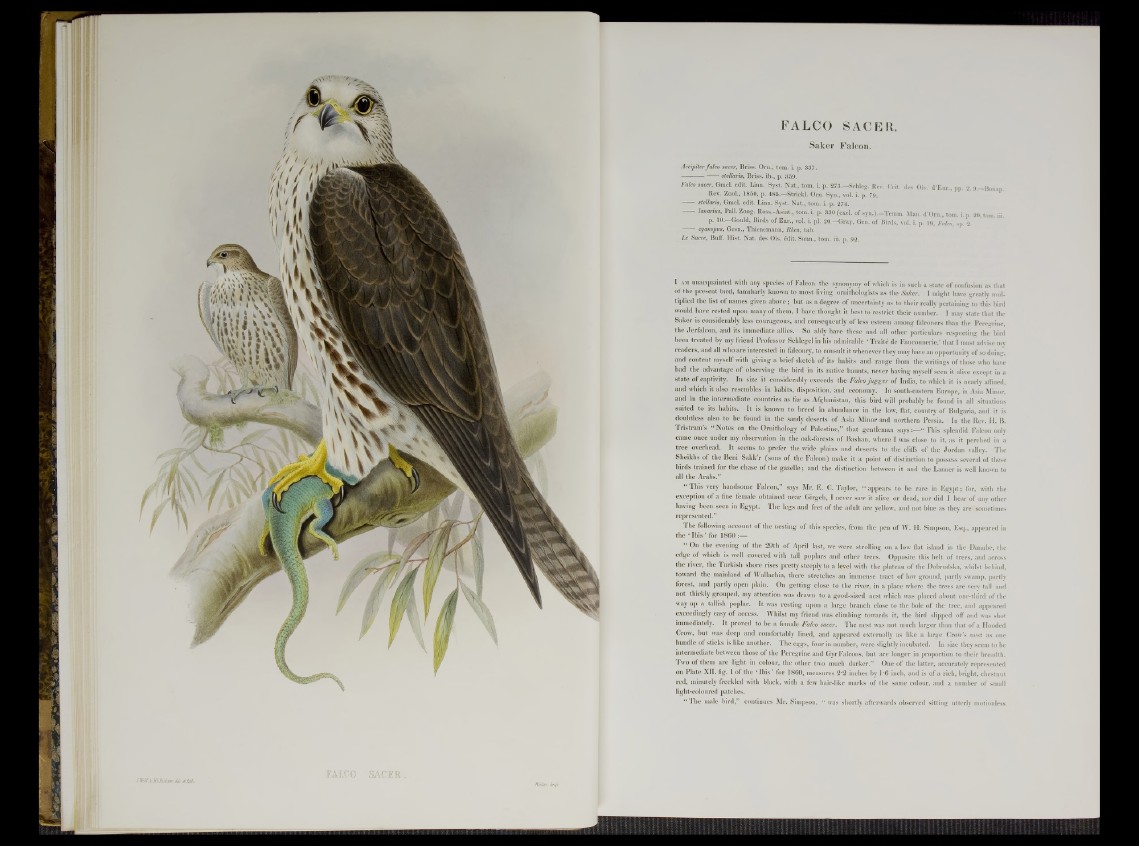
FALCO JW olf ibECBiehla: HI/ et/hth/.
SACER
FALCO SACER.
Saker Falcon.
Accipiter falco sacer, Briss. Orn., tom. i. p. 337.
------ stellaris, Briss. ib., p. 359.
Falco sacer, Gmel. edit. Linn. Syst. Nat., tom. i. p. 273—Schleg. Rev. Crit. des Ois. d’Eur., pp. 2, S.-Bonap.
Rev. Zool., 1850, p. 485.—Strickl. Orn. Syn„ vol. i. p. 79.
¿stellaris, Gmel. edit. Linn. Syst. Nat.^ tom. i. p. 274.
k"“™“’ M l.Zoog. Ross.-Asiat., tom.i. p. 330 (excl. of syn.)._Temm. Man. d'Om., tom. i.p. 20,tom.iii
p. 10—Gould, Birds of Eur., vol. i. pi. 20—Gray, Gen. of Birds, vol. i. p. is , Falco, sp. 2.
cyanopus, Gesn., Thienemann, Rhea, tab.
Le Sacre, Buff. Hist. Nat. des Ois. edit. Sonn., tom. iii. p. 92.
I am unacquainted with any species of Falcon the synonymy of which is in such a state of confusion as that
of the present bird, familiarly known to most living ornithologists as the Saker. I might have greatly multiplied
the list of names given above; but as a degree of uncertainty as to their really pertaining to this bird
would have rested upon many of them, I have thought it best to restrict tbeir number. I may state that the
Saker is considerably less courageous, and consequently of less esteem among falconers than the Peregrine,
the Jerfalcon, and its immediate allies. So ably have these and all other particulars respecting the bird
been treated by my friend Professor Schlegel in his admirable ‘ Traite de Fauconnerie,’ that I must advise my
readers, and all who are interested in falconry, to consult it whenever they may have an opportunity of so doing,
and content myself with giving a brief sketch of its habits and range from the writings of those who have
had the advantage of observing the bird in its native haunts, never having myself seen it alive except in a
state of captivity. In size it considerably exceeds the Falco jugger of India, to which it is nearly affined,
and which it also resembles in habits, disposition, and economy. In south-eastern Europe, in Asia Minor,
and in the intermediate countries as far as Afghanistan, this bird will probably be found in all situations
suited to its habits. It is known to breed in abundance in the low, flat, country of Bulgaria, and it is
doubtless also to be found in the sandy deserts of Asia Minor and northern Persia. In the Rev. H. B.
Tristram’s “ Notes on the Ornithology of Palestine,” that gentleman s a y s “ This splendid Falcon only
came once under my observation in the oak-forests of Bashan, where I was close to it, as it perched in a
tree overhead. It seems to prefer the wide plains and deserts to the cliffs of the Jordan valley. The
Sheikhs of the Beni Sakk r (sons of the Falcon) make it a point of distinction to possess several of these
birds trained for the chase of the gazelle; and the distinction between it and the Lanner is well known to
all the Arabs.”
“ This very handsome Falcon,” says Mr. E. C. Taylor, “ appears to be rare in Egypt; for, with the
exception of a fine female obtained near Girgeh, I never saw it alive or dead, nor did I hear of any other
having been seen in Egypt. The legs and feet of the adult are yellow, and not blue as they are sometimes
represented.”
The following account of the nesting of this species, from the pen of W. H. Simpson, Esq., appeared in
the ‘ Ibis’ for 1860 : =
“ On the evening of the 29th of April last, we were strolling on a low flat island in the Danube, the
edge of which is well covered with tall poplars and other trees. Opposite this belt of trees, and across
the river, the Turkish shore rises pretty steeply to a level with the plateau of the Dobrudska, whilst behind,
toward the mainland of Wallachia, there stretches an immense tract of low ground, partly swamp, partly
forest, and partly open plain. On getting close to the river, in a place where the trees are very tall and
not thickly grouped, my attention was drawn to a good-sized nest which was placed about one-third of the
way up a tallish poplar. It was resting upon a large branch close to the bole of the tree, and appeared
exceedingly easy of access. Whilst my friend was climbing towards if, the bird slipped off and was shot
immediately. It proved to be a female Falco sacer. The nest was not much larger than that of a Hooded
Crow, but was deep and comfortably lined, and appeared externally as like a large Crow’s nest as one
bundle of sticks is like another. The eggs, four in number, were slightly incubated. In size they seem to be
intermediate between those of the Peregrine and Gyr Falcons, but are longer in proportion to their breadth.
Two of them are light in colour, the other two much darker.” One of the latter, accurately represented
on Plate XII. fig. 1 of the ‘ Ibis’ for 1860, measures 2’2 inches by 1*6 inch, and is of a rich, bright, chestnut
red, minutely freckled with black, with a few hair-like marks of the same colour, and a number of small
light-coloured patches.
“ The male bird,” continues Mr. Simpson, “ was shortly afterwards observed sitting utterly motionless